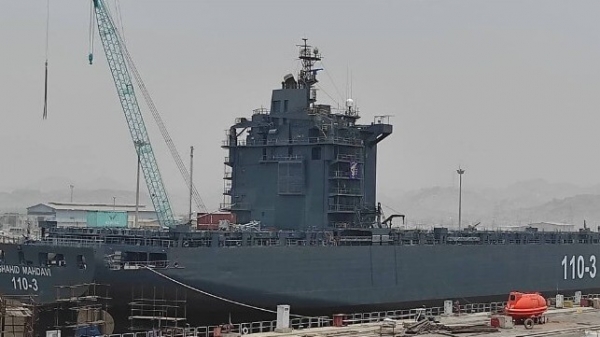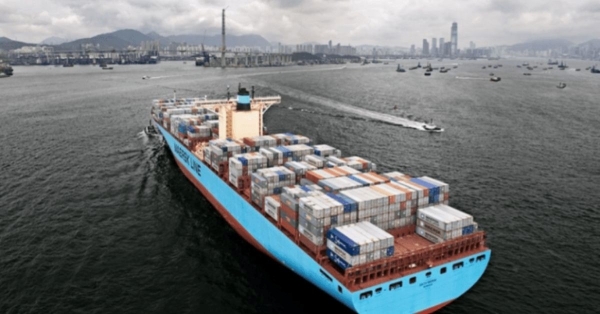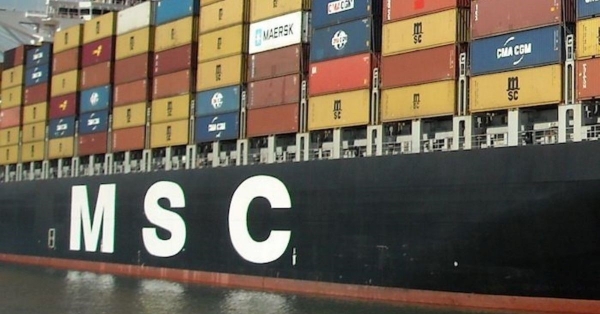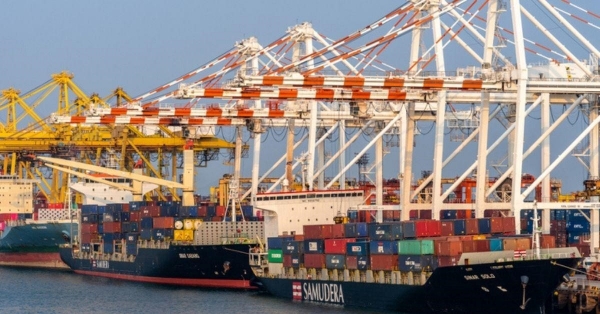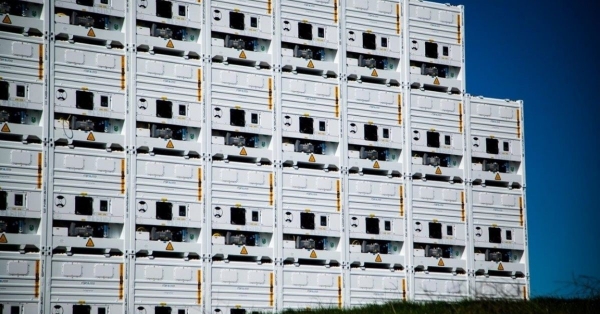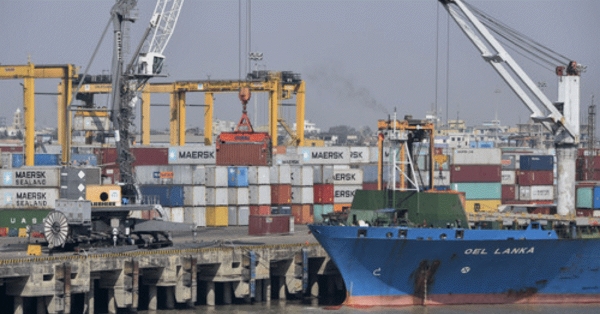News
Latest news
Iran CG Calls For Barter Mechanism To Facilitate Bilateral Trade
Consul General of Iran Mehran Movahedfar suggested that both Iran and Pakistan should devise a barter mechanism on the basis of local currencies to facilitate bilateral trade.
He expressed these views while addressing a ceremony held to mark the 44th anniversary of Islamic revolution in Iran. Punjab Governor Balighur Rehman was chief guest.
CG Iran said because of lack of banking channels, custom tariff and non-tariff obstacles have made trade between the businesses of both countries difficult. He urged that government of Pakistan should take steps for increasing legal trade with Tehran and promoting linkages between financial institutions of both the countries.
He suggested that there should be a barter system on the basis of local currencies adding that Iran is already successfully operating such a system with China, Russia and other countries. He said despite sanctions Iran was ready to meet energy needs of Pakistan.
Punjab Governor Balighur Rehman, who was chief guest at the event, hoped that governments of both the neighboring countries would be able to devise some trade system to the mutual benefit of their peoples.
Prominent among those present on the occasion were PML-N’s Muhammad Mehdi, PML-Q’s Chaudhry Shafay Hussain, PTI leader Senator Waleed Iqbal, retired Justice Nasira Javed Iqbal, Dr Amjad Abbas Magsi and film producer Syed Noor.
Kazakhstan To Sign Transit Trade Treaty With Pakistan
Yerzhan Kistafin, Ambassador of Kazakhstan, has said that his country desired to sign a transit trade treaty with Pakistan.
The treaty is very important as it will provide a legal framework to the businesspeople of both countries for developing trade ties.
“We are also planning to sign an agreement between the State Bank of Pakistan and National Bank of Kazakhstan to develop legal framework for cooperation in the banking sector,” he added.
The ambassador said that his embassy is further planning to arrange visit of President of Kazakhstan to Pakistan this year and we will be signing a number of bilateral agreements, MOUs and commercial contracts during the said visit of our President.
“I invite Karachi Chamber to be part of the success story and I am pretty sure that with your contribution, we will be able to further strengthen the existing ties,” he said while speaking at a meeting during his visit to the Karachi Chamber of Commerce & Industry (KCCI).
Senior Vice President KCCI Touseef Ahmed, Vice President KCCI Haris Agar, Chairman Diplomatic Missions & Embassies Liaison Subcommittee Zia ul Arfeen, Former President KCCI Muhammad Idrees, Former SVP Arshad Islam, Former VP Qazi Zahid Hussain and KCCI Managing Committee6 Members also attended the meeting.
Kazakhstani Ambassador also expressed the intentions to develop cooperation between the businesspeople in Karachi and Almaty by declaring them as sister cities, in addition to developing cooperation between Karachi Chamber and Chamber of Commerce of Almaty which would certainly give boost trade and economic cooperation between the two countries.
“We are also trying to connect transit land routes between Kazakhstan and Pakistan and I am happy to see that TCS is now delivery consignments between two countries on a regular basis via Afghanistan and they can even provide insurance facility for your products,” he added.
While referring to his meetings from time to time with various Chambers of Commerce, he said that the business people, who are very pragmatic, raised three main issues hindering trade, investment and economic cooperation between Kazakhstan and Pakistan including lack of connectivity which was a major hurdle in developing bilateral trade but it has been resolved now as on April 26, direct flight between Lahore and Almaty will be launched which will be followed by commencement of direct flights Karachi and Almaty from May this year.
“The second issue identified was pertaining to visa facilitation which has also been fixed by our Embassy as we now take around three to five days only to issue visa to those individuals who submit a letter from Chamber of Commerce along with their visa application,” said Yerzhan Kistafin.
“The third issue was pertaining to banking and I can happily inform that during our Deputy Prime Minister’s visit to Islamabad in December last year to attend 11th session of bilateral Inter-governmental Joint Commission, an MoU was signed between Bank of Punjab and Bank Center Credit Kazakhstan for establishing cooperation between our banks which would result in availability of formal banking channel facilitating all the transactions of businesspeople.”
He further noted that for the first time, businesspeople from Kazakhstan visited Islamabad, Lahore and Karachi in the month of February whereas Single Country Exhibitions were also staged in Pakistan and Almaty wherein more than 100 businesspeople from Pakistan participated. “The business communities of the two countries can develop cooperation in pharmaceutical, sports goods, agriculture, textile, construction and IT sectors etc. All we need is to develop strong connections between our businesspeople.”
While requesting KCCI to send a trade delegation to Kazakhstan on commencement of direct flight from Karachi in May, he said that Karachi was the financial hub of Pakistan, hence, its business community should take lead in further developing trade and investment cooperation between the two countries.
Earlier, Senior Vice President KCCI Touseef Ahmed, while warmly welcoming the Ambassador, stated that Kazakhstan was a part of the Eurasian Economic Union (EAEU) which was an economic regional block comprising Armenia, Belarus, Kazakhstan, Kyrgyzstan & Russia formed in 2015, hence, Pakistan can take advantage of easily accessing the huge Eurasian market through Kazakhstan.
“Despite strong bilateral relations between the two countries, Pakistan’s exports to Kazakhstan stood at a meagre of $107.87 million in FY22 as compared to $79.69 million in FY21, representing a growth of around 35.36 percent but during six months of current fiscal year, our exports to Kazakhstan dropped by 42 percent to $36.62 million compared to $68 million last year which needs to enhanced to a reasonable level through mutual cooperation”, he said.
Touseef Ahmed also invited Kazakhstani authorities and the business community to participate in Karachi Chamber’s “My Karachi Exhibition beginning from 3rd to 5th March 2023 which would be a wonderful platform for Kazakhstani private sector to explore businesses, markets & investment opportunities. He was of the view that both countries have great potential for diversifying trade relations and entering into joint ventures in the areas of agriculture, processing, IT, textile, energy, logistics, housing & construction sector. “CPEC and Gwadar Port provide shortest route to Kazakhstan for strengthening bilateral trade, exports and economic development and improving connectivity.”
China’s Warming Foreign Trade Boosts Global Economic Recovery
The booming orders in 2023 marks a rebound in foreign trade of Guangdong Province, a primary economic hub, injecting new impetus into the global economic recovery.
The booming orders at the beginning of 2023 mark a robust rebound in foreign trade in south China’s Guangdong Province, a primary economic hub, injecting new impetus into the global economic recovery.
With eased epidemic controls and resumed international communication, particularly the economic and trade contacts, some factories in Huizhou City, Guangdong, are facing surging orders from overseas and a growing demand for industrial workers. Fierce competition to grab orders in the broad overseas markets is also in sight among Chinese enterprises.
The Guangdong One Nano Technology Co., Ltd. in Zhongkai High-tech Zone of Huizhou is now fully engaged in the spring recruitment and plans to double the size of its staff in 2023, following an increase of 279 percent in its revenue in 2022 and a busy order schedule for various nanomaterials before the second quarter of 2023.
“We are highly confident and motivated. We want to get our business off to a good start in the first quarter and strive to increase our production value by 10 percent this year,” said Zhang Qian, general manager of Huizhou Macc Electronics Co., Ltd., which has sent a marketing team to visit clients for cooperation chances in the Middle East, Europe, the U.S.A. and the Republic of Korea.
Overall, the economic operation saw a striking recovery trend as the upstream and downstream of the industrial chain strengthened and market expectations improved. Statistics show that Chinese enterprises have robust confidence and optimistic prospects.
The purchasing managers’ index for China’s manufacturing sector rose 3.1 percent from the previous month to 50.1 percent in January, while the new orders index rose seven percentage points to 50.9 percent, according to a recent release by the service industry survey center of the National Bureau of Statistics and the China Federation of Logistics and Purchasing.
The outstanding performance is part and parcel of the efforts by Chinese enterprises regarding digital transformation and business format innovation.
Benefiting from the expansion of the intelligent manufacturing production lines and automatic assembly lines, as well as the update of the information managing system, Galanz, a Foshan-based home appliance manufacturer, has received rapidly growing foreign-trade orders for microwave ovens, toasters, and ovens and dishwashers.
Apart from production, enterprises also attach more importance to cross-border e-commerce, greatly facilitating their foreign trade business.
“Our salesmen were busy with orders received during the Spring Festival. The inquiries and orders on Alibaba.com over the holiday were higher than usual, totaling more than 3 million U.S. dollars,” said Zhao Yunqi, general manager of Sunway Solar Co., Ltd., whose rooftop solar photovoltaic (PV) systems are distributed to the overseas warehouse upon production due to the burgeoning order number.
Cross-border e-commerce platforms like Alibaba.com have become an accelerator for new business formats to develop. The cross-border index on Alibaba.com shows that high-quality business opportunities in the new energy industry on the platform have increased by 92 percent, making it an export highlight.
The platform also plans to launch 100 overseas digital exhibitions this year, together with 30,000 cross-border live broadcasts and 40 press conferences for new products in March.
Despite challenges such as the rising risk of global economic recession and slowing growth of overseas market demand, China’s import and export potential and contribution to the world economy remain promising.
The deepened opening up of China’s economy and recovery in domestic demand could boost global economic growth by about one percent in 2023, according to a late report by the Goldman Sachs Group.
China will stick to a high-level opening up to make foreign trade more convenient and rewarding by multiple methods. Offline domestic export exhibitions will resume, and enterprises will receive full support to participate in professional expos abroad.
China will also strengthen cooperation with trading partners, leverage the advantages of its massive market, increase quality product imports from other countries, and stabilize the global trade supply chain, according to an official of the Chinese Ministry of Commerce.
The 133rd China Import and Export Fair, or Canton Fair, scheduled to open on April 15, will fully resume offline exhibitions. Chu Shijia, director of the China Foreign Trade Center, said that more than 40,000 enterprises have applied to participate. The number of offline exhibition booths is expected to increase from 60,000 to nearly 70,000.
“The full recovery of the exhibition industry will accelerate, and the flourishing of trade, investment, consumption, tourism, catering, and other industries will follow,” said Chu, who noted that significant development and improvement of the Canton Fair will also better contribute to high-quality economic development.
Iran is Converting Two Panamax Boxships Into "Drone Carriers"
The Iranian Islamic Revolutionary Guard Corps' boxship-to-warship conversion project appears to be aimed at producing drone carriers, according to Iranian social media and naval analyst H.I. Sutton.
Last year, open-source intelligence analysts obtained a photo of what appeared to be a new IRGC "base ship" in shipyard at Bandar Abbas. The vessel's deckhouse and hull were painted in a coat of haze gray, with gun emplacements on the stern - but her lines were identical to a Panamax boxship belonging to sanctioned Iranian shipping line IRISL. It appeared that a disused container ship had been transferred to the IRGC for conversion into a mobile military logistics platform.
However, the details may differ slightly. New photos analyzed by H.I. Sutton appear to indicate that the ship is being fitted with a giant, overhanging deck on her port side, like an exaggerated version of an aircraft carrier's flight deck. The wing-shaped appendage appears to increase the beam of the ship by about one third, on one side only.
While this may not quite be an aircraft carrier, neither does it appear to be a "base ship." Iranian local media accounts suggest that the vessel will become something unique: a storage and launch platform for Iran's militarized drones, reports USNI News.
It also appears that the IRGC will be converting two boxships to a drone carrier configuration. One has been reported as the former 3,300 TEU boxship Sarvin - currently listed in Equasis as "in repair/conversion" - and Sutton has identified the other as a sister ship, the Perarin. Both were last seen on AIS in 2019, lying at anchor off Bandar Abbas.
Iran has invested in drone warfare for decades, and its capabilities are on demonstration on a daily basis in Ukraine, where Russia is using hundreds of imported Iranian Shahed-136 "suicide" drones to bombard the nation's power grid. Iran's drone systems have also been used prolifically by its proxy forces in the Middle East, notably Yemen's Houthi rebels.
On Saturday, in a preview of how an Iranian "drone carrier" might operate in conflict, the Iranian Navy test-launched an Ababil suicide drone from the deck of the landing ship IRIS Lavan. The drone flew inland to a target site and struck what appeared to be a mockup of Israel's Eliat Naval Base.
Maersk, Ashdod Port Ink Supply Chain Partnership Deal
Ashdod Port Company in Israel has struck a deal with Maersk North America to work on supply chain logistics innovation potential.
The partnership is expected to allow Israeli firms participating in the Blue Ocean for Startups technological incubator at Ashdod Port to be eligible for pilot projects in North America to test the suggested solutions in landside operations.
The partnership was struck during the Manifest conference in Las Vegas, which is one of the world’s major logistics conventions.
“This type of collaboration is critical, so we can upgrade the entire supply chain, the source of the modern global economy, and make it more efficient,” stated Orna Hozman Bechor, chairman of the board of Ashdod Port.
Earlier in 2021, Maersk signed an innovation partnership agreement with the Massachusetts Institute of Technology (MIT) Center for Transportation & Logistics. MIT’s world-renowned engineering skills and data scientist teams will work to investigate methods to improve Maersk North America’s logistics and data operations.
Ashdod Port was represented at the signing by the chairman of the board Orna Hozman Bechor and chief innovation officer Roy Avrahami. Erez Agmoni, senior vice president of innovation and strategic growth at Maersk, represented the company.
“The pandemic highlighted the importance of supply chains to constantly improve. This new partnership enables us to accelerate and test technology and new ideas in our operational processes using Ashdod Port’s tech incubator, ” noted Erez Agmoni, Maersk North America’s senior vice president of Innovation and Strategic Growth.
MSC Announces New Container Service In Europe
The service will connect Dublin and Cork in Ireland to two key transshipment hubs in Northwestern Europe, Antwerp in Belgium and Le Havre in France.
MSC has decided to start a new weekly feeder service connecting Ireland, France and Belgium, effective from the end of February.
The service will connect Dublin and Cork in Ireland to two key transshipment hubs in Northwestern Europe, Antwerp in Belgium and Le Havre in France.
The first direct call to Dublin will be on 28 February and then to Cork on 3 March with the 1,726 TEU boxship Carla-Liv.
The rotation will be Antwerp – Dublin – Cork – Le Havre – Antwerp.

Freightify To Digitise Freight Forwarding
Freightify announced a US$12 million debt & equity Series A funding round to help power the digital transformation of freight forwarders through its solutions.
The company’s freight rate management platform is solving the complex challenges facing freight forwarders and helping them to do more business faster at lower costs.
Freightify aims to empower freight forwarders by providing rate automation solutions to digitise their rate procurement, rate management and quotation processes with ease.
The platform also allows any forwarder to create a digital storefront to serve their customers better. In addition to this, it includes track and trace solutions that help freight forwarders in getting the live location of vessels and automated milestones within seconds.
Furthermore, Freightify’s new funding round will help launch new functionalities and deliver a strong and expanded product roadmap, as they expand into new geographies and segments, according to the company.
The round was led by Sequoia Capital India with participation from TMV and Alteria Capital. The round also includes returning investors Nordic Eye Venture Capital and Motion Ventures.
Raghavendran Viswanathan, CEO of Freightify, commented, “We set up Freightify to remove the heavy lifting of manually providing quotations, accepting email/telephonic bookings, managing documentation, coordinating and tracking shipments.”
Refrigerated Container Rates Cool To Pre-Pandemic Levels
Shipping rates for refrigerated containers have returned to around pre-pandemic levels, according to William Duggan, North America advisor at New Jersey-based Eskesen Advisory, a boutique consulting firm that serves the refrigerated transportation sector.
While dry cargo rates have fallen sharply over the past year, it is a mistake to think that reefer rates have done the same since they never spiked to the same degree as the dry market during the COVID-19 container shipping crisis, Duggan told delegates at the recent National Fisheries Institute (NFI) Global Seafood Market Conference in Palm Springs last month.
“Rates overall on refrigerated business are at about pre-pandemic levels but that’s more of a tweak on the east and west bound,” Duggan said.
“North and south rates are pretty much over 2022. That’s because demand for space and equipment is still there and the supply demand ratios are in favor of holding the rate levels.”
The east-west refrigerated container market shipping seafood to Asian markets, including China for reprocessing, is completely different to that on north-south routes.
The United States, for example, gets most of its refrigerated imports in via north-south routes, posing implications for those shipping in shrimp from Ecuador and frozen Chilean salmon and frozen Brazilian tilapia.
Container rates more than quadrupled following the onset of the global COVID-19 pandemic, rising particularly steeply in 2021, but have since cooled significantly.
Following the onset of the pandemic in early 2020, the seafood and many other industries suffered from soaring shipping rates and reduced shipping options, battling for space aboard vessels.
The crisis began in early 2020 when containers became stranded where they were not needed due to congestion at ports sparked by COVID checks combined with spikes in demand for commodities and consumer goods, shipped particularly from China.
Last year, shipping sector analysts Drewry forecast modest declines through 2023 in its Reefer Shipping Annual Review and Forecast 2022/23 report.
Lower reefer charges come as the era of sharp increases in marine cargo insurance for seafood exporters largely slips into the past.
But while these rates may be falling, the main issue is on land, with the US food industry is facing a 10 percent shortfall in cold storage capacity at a time when refrigerated warehouse space is already tight and companies are struggling to shake off the after effects of the pandemic.
Chittagong Port Welcomes Vessels With 10 Meters Draft
A vessel with 10 metres draught berthed at a jetty of the Chattogram port for the first time, a major leap forward as the movement of larger ships is expected to cut costs and save time
Port users hope that the increased draught limit would enable the transportation of more cargoes and containers by a single vessel and help ease congestion at the seaport, which handles around 90 per cent of Bangladesh’s $135 billion annual trade.
“It is very good news,” said Faruque Hassan, president of the Bangladesh Garment Manufacturers and Exporters Association.
Owing to the lower draught in the Karnaphuli channel, relatively larger ships could not enter the channel as of yesterday. Now they will be able to come with higher loads.
“It is a good signal to international shipping companies. Our buyers will also become happy,” Hassan said.
“The port is performing well and further dredging would increase the depth of the channel.”
Port users say initially container vessels would benefit from the move since the new draught limit is applicable for only the container jetties at General Cargo Berth, Chittagong Container Terminal (CCT) and New Mooring Container Terminal.
A team led by CPA Member (Harbour) Commodore M Fazlar Rahman successfully berthed MV Common Atlas, a Marshal Island-flagged vessel, at a jetty of the CCT at 5.24pm yesterday. The vessel arrived from the Port of Santos of Brazil with 60,500 tonnes of sugar.
The vessels with a draught of up to 7.5 metres and a length of 160 metres could berth at the port in 1975. The Chittagong Port Authority (CPA) gradually increased the draught limit in the last 47 years to cope with the increasing trade demand.
Until yesterday, ships with a maximum 9.5-metre draught, the vertical distance between the waterline and the bottom of the ship’s hull, and of up to 190 metres in length could berth at some of the port’s main jetties.
The authority has fixed the new draught limit upon recommendation by United Kingdom-based consultant firm HR Wallingford.
The firm conducted a detailed hydrological study in the Karnaphuli and gave the opinion that the port can accommodate vessels with 10 metres in draught, said CPA Secretary Md Omar Faruk.
“The navigability of the port channel and the jetty areas has improved thanks to the prevention of siltation through continuous maintenance and dredging. This enabled the port to raise the draught limit.”
Bangladesh Shipping Agents Association (BSAA) Chairman Syed Md Arif said till to date, container vessels arriving at the port jetties could carry around 2,000 twenty-foot equivalent units (TEUs) of containers to 2,500 TEUs.
“With the new draught and length limit, vessels would now be able to carry at least 500 TEUs to 700 TEUs more.”
As vessels would be able to carry more containers, freight costs would be reduced, leading to a decrease in import and export costs. The turnaround time of vessels would also come down, he said.
“Definitely, this will help us save a lot,” said Abdul Bashar Chowdhury, chairman of BSM Group, a commodity importer based in Chattogram.
An importer could bring 20,000 tonnes of imported items in a vessel with up to an 8.5-metre draught. Now, businesses will able to bring about 10,000 tonnes more goods in a single ship.
“This will give more comfort to shipping companies and help save time as importers will not need to use smaller vehicles to bring cargoes to the port jetty.
The risk of pilferage will also decline. Overall, the efficiency will improve,” Chowdhury said.
BSAA Chairman Arif, however, said initially bulk vessels may not reap the benefit since six jetties dedicated to such ships are having as high as 8.5 metres draught.
BGMEA’s Hassan, also the managing director of Giant Textiles Ltd, said the authorities should speed up the construction of the Bay Terminal and other projects to allow much bigger ships to come.
State Minister for Shipping Khalid Mahmud Chowdhury is scheduled to inaugurate the berthing of the 10-metre-draught vessel today.
All Entry-Exit Points Of Chittagong Port To Get Scanners
The process to install scanners at all the entry and exit points of the port is underway. Mongla Port and all land ports will also be installed with scanners to ensure free flow of exim goods.
State Minister for Shipping Khalid Mahmud Chowdhury has said that the Chittagong Port is the “lifeline” of Bangladesh’s economy.
The process to install scanners, at all the entry and exit points of the port, is underway to ensure top-notch security, he added.
“Scanners will be installed at each of the port’s gates for smooth import and export,” the state minister said during his visit to the New Mooring Container Terminal of the Chittagong Port on Sunday.
“The Mongla Port is getting scanners. Besides, scanners are also being installed in all land ports of the country.”
The state minister also said that according to the agreement with India, their ships can use Chittagong Port and from where goods can be delivered to the neighbouring country’s other states via Bangladesh.
“For this, trial runs of Indian ships have taken place at the Chittagong Port. There will be more trials. The port is being further developed. Patenga Container Terminal and an overflow yard have been constructed.
He also said that Chittagong port is ready to handle the pressure of more ships. Indian ships will start arriving on a regular basis once the National Board of Revenue (NBR) issues Statutory Regulatory Orders (SROs).
Chittagong Port Authority (CPA) Chairman Rear Admiral M Shahjahan, Member (Administration and Planning) Md Zafar Alam, Member (Engineering) Captain Md Mahbubur Rahman received the state minister at port among others.
According to officials, out of the 12 gates of the port, there are currently seven scanning machines in operation in six gates.























